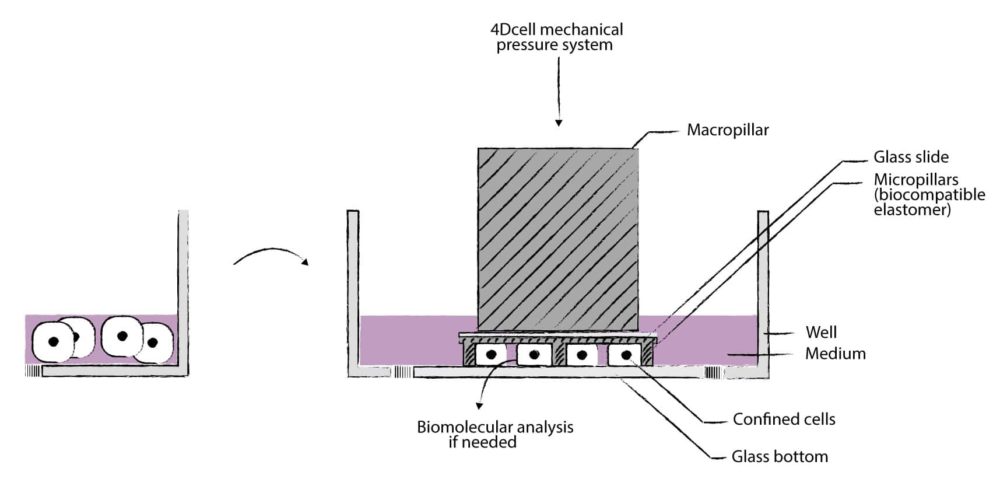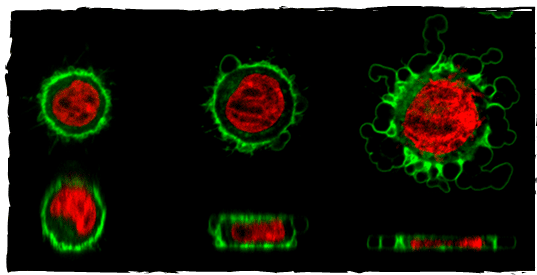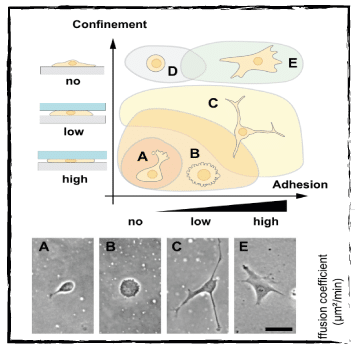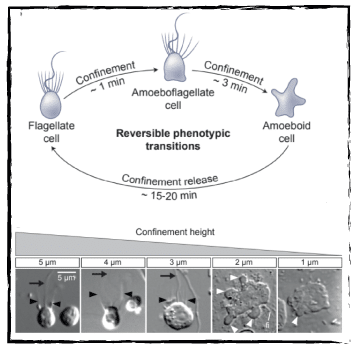Cell confinement
Control cells between two parallel surfaces
Control cells between two parallel surfaces
Cells are homogeneously confined/compressed between two parallel surfaces to a defined micrometer height with sub-micrometer resolution.
Different confinement heights available (e.g. 1 µm – 300 µm)
Allows long-term cell culture and cell proliferation to proceed while preserving perfect control of confinement
Compatible with high-resolution optical microscopy systems
Can process a sufficiently large number of cells to allow whole gene expression analyses to be performed
Can be combined with bio-functionalized micro-structured substrates and/or with different matrices (geometry control)
Can be combined with gels (stiffness control)
Compatible Petri dishes of 35 mm and 6-well plates
For customized designs, please contact us

Cell migration 2.5D, migration and interaction of non-adhesive cells, cell squeezing, imaging of flat cells (organelles aligned in 2D), super-resolution video-microscopy (organelles move less), contractility assay, etc

HeLa cells: not confined, 5 µm, 3 µm.
Nuclear bebling and laminar rupture is modulated by the degree of cell confinement

Cell migration phenotype behaviour is affected by degree of confinement height and adhesion

Cells undergo phenotypic transition in response to confinement height
Explore examples of applications
> Cancer invasiveness assay: Quantification of migration behaviors and migration transitions
> Cancer aggressiveness assay: Quantification of contractility of somatic or cancer cells
> Endocytosis assay: Improved observation of events taking place at the membrane
> Exocytosis assay: Improved observation of events taking place at the apical membrane
> Frustrated phagocytosis: Characterization of the mechanism
> Immune system in a well: 2D migration and interaction of non-adherent immune cells
> Immune cells interaction: 2D interaction of non-adherent immune cells
> Mitotic spindle assembly assay: Quantification of mitotic spindle disorders
> Quantitative cell migration assay: Fast and fine analysis of cell migration properties
Read more
The static confiner offers the possibility to observe the effect of confinement on your cells, in a static state, and compare it to the « normal » cell state.
The dynamic confiner is suited for varying the confinement on the cells, in a dynamic way, confining and retrieving or even varying the strength.
The Cell Confiner can be used multiple times, depending on the use and handling. To keep them longer, be sure to handle them gently and clean them properly after each use with 70% ethanol.
Each system includes a set of spare parts for you to replace some parts at least once if needed. We also provide additional consumables on demand.
The height of the culture can be controlled thanks to a micropillar system anchored to a glass slide, which is pushed/pulled by a suction cup. The height of the pillars can be adjusted from 3 µm to 20 µm.
In order for you to first try the 4Dcell products, we provide affordable starter packs (with either 20 or 50 articles). Therefore, you can have a first impression and confirm your experimental needs before ordering the appropriate products.
When you have decided which products you want to order, you can send us an order form. We will send you an invoice so that you can pay by bank transfer or with a Paypal account.If you have a special request concerning the payment method, contact us and we will find an appropriate solution.
We send the products in a delay of one month from the day we receive the order form.
All 4Dcell products can be sent worldwide. 4Dcell works with a Chinese distributor for the Asian market.